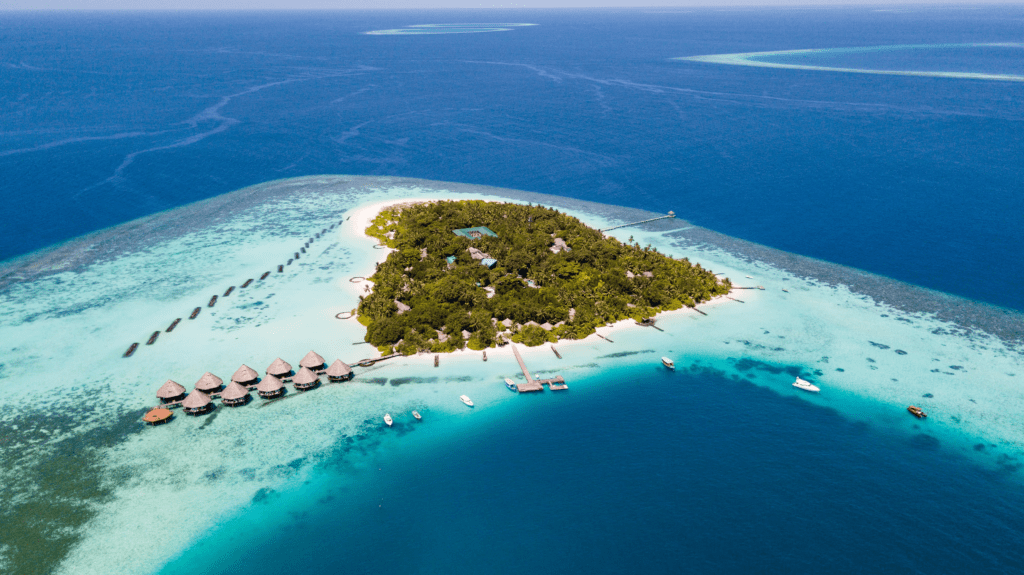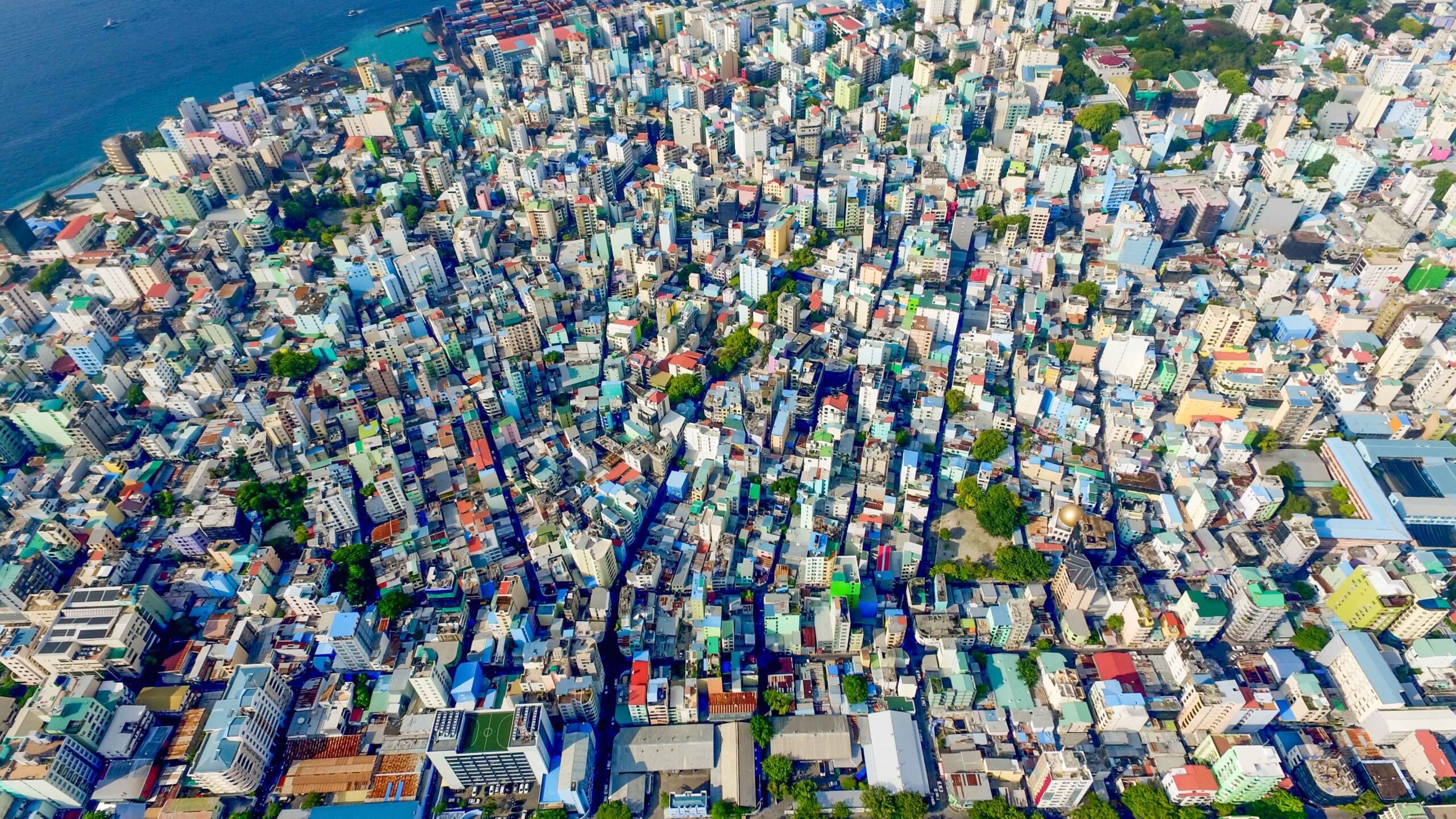Introduction
Where Are the Maldives Located? The Maldives, a tropical paradise renowned for its pristine beaches, crystal-clear turquoise waters, and vibrant coral reefs, is a dream destination for many. In this comprehensive guide, we embark on a journey to answer the fundamental question: Where are the Maldives located? Delving into geography, culture, and travel insights, we aim to provide a detailed exploration of the Maldives’ geographical position and the factors that make it a unique and sought-after destination.

I. Geography of the Maldives
A. Location in the Indian Ocean
The Maldives is an archipelago situated in the Indian Ocean, southwest of Sri Lanka and India. Comprising 26 atolls that form a chain of 1,192 coral islands, the Maldives stretches across approximately 90,000 square kilometers.
To understand the allure of the Maldives, it’s crucial to grasp its geographical position in the vast expanse of the Indian Ocean.
B. Coordinates and Map Position
The Maldives is located between latitudes 4°10’30” N and 7°6’30” S and longitudes 72°32’30” and 73°45’54” E. These coordinates place the Maldives to the southwest of the Indian subcontinent and position it as one of the world’s most geographically dispersed countries.
Pinpointing the precise coordinates on a map allows us to visualize the Maldives’ location in relation to neighboring countries and the Indian Ocean.
II. The Maldives Islands: A Closer Look
A. Composition of Atolls and Islands
Understanding the layout of the Maldives involves recognizing the significance of atolls. An atoll is a ring-shaped coral reef, island, or series of islets that encircle a lagoon either partially or completely. The Maldives’ 26 atolls are composed of over 1,000 coral islands, each contributing to the archipelago’s unique charm.
Examining the composition of atolls offers insight into the intricate beauty of the Maldives islands.
B. Popular Atolls and Islands
- Malé Atoll
Malé Atoll, the capital’s namesake, is home to Malé, the Maldives’ capital city. Beyond the urban center, the atoll features pristine beaches, coral gardens, and resorts, making it a hub for both cultural experiences and natural beauty.

Exploring Malé Atoll unveils a blend of urban life and natural wonders, showcasing the diversity within the Maldives archipelago.
- Baa Atoll
Baa Atoll is renowned for its designation as a UNESCO Biosphere Reserve, hosting a rich biodiversity of marine life. The atoll’s Hanifaru Bay is particularly famous for attracting manta rays and whale sharks, offering a unique opportunity for underwater enthusiasts.
Moving to Baa Atoll, the Maldives reveals its commitment to conservation, creating a haven for marine species and a paradise for eco-conscious travelers.
III. Maldivian Culture and Heritage
A. Influences on Maldivian Culture
The Maldives’ geographical location has shaped its cultural identity through influences from neighboring countries. While retaining its unique Maldivian character, the culture reflects elements of Indian, Sri Lankan, and Arab traditions.
Examining the cultural fabric of the Maldives provides a deeper understanding of the diverse influences that have contributed to its distinctive identity.
B. Language and Religion
Dhivehi, the Maldivian language, is influenced by Indo-Aryan languages and has its own script. Islam plays a central role in Maldivian life, with the majority of the population adhering to Sunni Islam.
Language and religion act as pillars of Maldivian culture, fostering a sense of unity and identity among the island nation’s inhabitants.
IV. Travel Insights: Getting to and Exploring the Maldives
A. Air Travel to the Maldives
Travelers can reach the Maldives by air, with Malé International Airport serving as the primary gateway. Direct flights from major international airports connect visitors to this tropical paradise, ensuring convenient access to the islands.
Navigating the logistics of air travel sets the stage for an exploration of the logistical aspects of reaching the Maldives.

B. Transportation within the Maldives
Once in the Maldives, transportation between islands is facilitated by a network of domestic airports, seaplanes, and speedboats. Each mode of transportation offers a unique perspective of the islands, allowing visitors to experience the Maldives’ breathtaking scenery.
From air travel to inter-island transportation, the Maldives offers a seamless and picturesque journey for those eager to explore its diverse landscapes.
V. Where is Maldives Located: Practical Considerations
A. Climate and Weather
Situated near the equator, the Maldives experiences a tropical climate with two distinct seasons: the dry northeast monsoon (Iruvai) and the wet southwest monsoon (Hulhangu). Understanding the weather patterns is crucial for planning an ideal visit.
Considering the climate adds a practical dimension to the question of where the Maldives is located, helping travelers choose the best time for their visit.
B. Tourism and Accommodations
Tourism is a major industry in the Maldives, and the archipelago is known for its luxurious overwater bungalows and resorts. Understanding the geography of the Maldives aids in selecting accommodations based on preferences, whether it be a private island resort or a guesthouse on a local inhabited island.
Linking the geography to tourism, the diverse accommodation options cater to a range of preferences, contributing to the allure of the Maldives.
VI. Conservation Efforts and Environmental Challenges
A. Coral Reefs and Marine Conservation
The Maldives, with its extensive coral reefs, faces challenges such as coral bleaching and rising sea temperatures. Conservation efforts, including marine protected areas and sustainable tourism practices, are crucial for preserving the Maldives’ rich biodiversity.
Exploring the delicate balance between tourism and conservation sheds light on the measures taken to safeguard the Maldives’ natural wonders.

B. Rising Sea Levels
As a low-lying island nation, the Maldives is particularly vulnerable to the impacts of climate change, including rising sea levels. This environmental challenge underscores the urgency of global efforts to address climate issues.
Addressing environmental challenges, the Maldives serves as a poignant reminder of the global impact of climate change on vulnerable island nations.
VII. The Future of the Maldives
A. Sustainable Tourism Initiatives
The Maldives is at the forefront of sustainable tourism initiatives, with resorts implementing eco-friendly practices and the government advocating for environmentally responsible tourism. These initiatives aim to strike a balance between economic development and environmental conservation.
Looking to the future, sustainable tourism initiatives chart a course for responsible development in the Maldives, ensuring the preservation of its natural beauty.
B. Technological Innovation
Technological advancements play a role in addressing environmental challenges, with innovations in sustainable energy, waste management, and marine conservation contributing to the Maldives’ efforts to build a resilient and eco-friendly future.
In the realm of technology, innovative solutions emerge as powerful tools for safeguarding the Maldives’ delicate ecosystem and supporting sustainable development.
VIII. Maldives: A Diverse Underwater World
A. Rich Marine Biodiversity
The Maldives is celebrated for its remarkable marine biodiversity, with colorful coral reefs and an abundance of marine life. Snorkeling and diving enthusiasts flock to the Maldives to witness the vibrant coral gardens and encounter a diverse array of marine species, including reef sharks, rays, and an assortment of tropical fish.
Delving into the underwater realm, the Maldives showcases an extraordinary diversity of marine life, making it a haven for underwater enthusiasts and nature lovers alike.
B. Famous Dive Sites
The Maldives boasts some of the world’s most famous dive sites, offering unique underwater landscapes and encounters. Sites like Maaya Thila, Kuredu Express, and the Maldives Victory wreck attract divers seeking thrilling experiences and the opportunity to explore the mysteries of the ocean depths.
Transitioning to dive sites, each underwater location in the Maldives presents a distinct and captivating experience, contributing to the archipelago’s reputation as a premier diving destination.

IX. Maldives: A Culinary Expedition
A. Seafood Delicacies
Given its location in the Indian Ocean, the Maldives is a paradise for seafood lovers. Traditional Maldivian cuisine often includes an array of fresh catches, including tuna, reef fish, and crustaceans. Visitors have the opportunity to savor these delights in local eateries and resort restaurants.
Shifting to culinary delights, exploring the seafood offerings in the Maldives provides a taste of the local flavors and the cultural significance of ocean-to-table dining.
B. Fusion of Flavors
The Maldivian culinary scene reflects a fusion of flavors influenced by Indian, Sri Lankan, Arabic, and other regional cuisines. The use of coconut, aromatic spices, and fresh tropical fruits creates a culinary experience that is both unique and diverse.
Examining the culinary landscape, the Maldives becomes not only a destination for sun and sand but also a haven for food enthusiasts seeking a delightful fusion of flavors.
X. Maldivian Arts and Crafts
A. Traditional Handicrafts
The Maldives has a rich tradition of arts and crafts, with artisans creating intricate handmade items that reflect the nation’s cultural heritage. Traditional crafts include lacquer work, woven mats, and wooden carvings, often showcasing the skill and creativity of local craftsmen.
Shifting to the realm of arts and crafts, exploring traditional Maldivian handicrafts provides a deeper connection to the cultural roots of the archipelago.
B. Maldivian Music and Dance
Music and dance are integral to Maldivian culture, with traditional performances featuring rhythmic drumming, bodu beru (big drum) performances, and graceful dances. Visitors have the opportunity to experience these cultural expressions during local festivals and events.
Transitioning to music and dance, the vibrant cultural performances in the Maldives add a rhythmic and joyful dimension to the overall visitor experience.
Conclusion
In conclusion, understanding where the Maldives is located goes beyond geographical coordinates; it encompasses a journey through culture, travel logistics, and environmental conservation. The Maldives, with its unique position in the Indian Ocean, invites travelers to explore a tropical haven where natural beauty and human endeavors coexist. As the nation grapples with environmental challenges, sustainable practices and a commitment to conservation pave the way for a future where the Maldives continues to enchant visitors while preserving its pristine landscapes for generations to come.

Read More: Solo Backpack Sprayer: A Comprehensive Guide to Solo Backpacks and Solo New York Backpacks
FAQs (Frequently Asked Questions) About the Maldives
A: The Maldives is an archipelago situated in the Indian Ocean, southwest of Sri Lanka and India. Its coordinates are approximately between latitudes 4°10’30” N and 7°6’30” S, and longitudes 72°32’30” and 73°45’54” E.
A: The Maldives comprises 26 atolls, forming a chain of 1,192 coral islands. While many islands are inhabited, a significant number remain uninhabited, contributing to the Maldives’ natural beauty and providing opportunities for secluded getaways.
A: The Maldives experiences a tropical climate with two distinct seasons: the dry northeast monsoon (Iruvai) and the wet southwest monsoon (Hulhangu). The dry season, from November to April, is considered the best time to visit for sunny days and calm seas.
A: Transportation between islands in the Maldives is facilitated by a network of domestic airports, seaplanes, and speedboats. Resorts often arrange transfers for guests, and the Maldives’ unique geography allows for picturesque journeys between islands.
A: The Maldives is actively engaged in marine conservation efforts, including the establishment of marine protected areas and sustainable tourism practices. Resorts and local communities contribute to environmental initiatives aimed at preserving coral reefs and protecting marine biodiversity.

